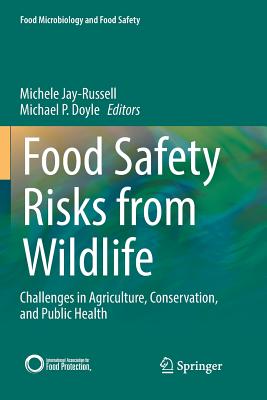Techniques to Measure Food Safety and Quality: Microbial, Chemical, and Sensory
暫譯: 食品安全與品質測量技術:微生物、化學及感官分析
Khan, Mohidus Samad, Shafiur Rahman, Mohammad
- 出版商: Springer
- 出版日期: 2021-09-23
- 售價: $9,760
- 貴賓價: 9.5 折 $9,272
- 語言: 英文
- 頁數: 477
- 裝訂: Hardcover - also called cloth, retail trade, or trade
- ISBN: 3030686353
- ISBN-13: 9783030686352
-
相關分類:
化學 Chemistry
海外代購書籍(需單獨結帳)
相關主題
商品描述
This book addresses the basic understanding of food contaminants and their sources, followed by the techniques to measure food safety and quality. It is divided into four parts: Part A - sources of contaminants in foods, their associated health risks, and integrated management and alternative options to minimize contaminants; Part B - Technological assessment of conventional methods and selected advanced methods for the detection, identification and enumeration of microbial contaminates; Part C - Technological assessment of different chemical measurements techniques; and Part D - Technological assessment of different instrumental techniques to assess sensory properties of foods.
Food safety is a growing concern due to the increase in food-borne illnesses caused by food adulteration, excessive use of pesticides, use of chemical preservatives and artificial fruit ripening agents, microbial contaminations, and improper food handling. Chemical contaminants in food could be transferred from environmental or agrochemical sources, personal care products, and other by-products of water disinfects. In addition, microbial food safety can be threatened due to the presence of many pathogens, such as Salmonella, Escherichia coli, Clostridium botulinum, Staphylococcus aureus, and Listeria monocytogenes in foods. Globally, strict regulations are imposed to limit the potential contaminants in foods. Development of accurate, rapid, and inexpensive approaches to test food contamination and adulteration would be highly valued to ensure global food safety. There are existing processes to ensure safety of food products from chemical and microbial contaminants. Apart from the existing measurement technologies, varieties of new techniques are also being emerged and these could be potential to ensure food safety and quality.
In addition to chemical and microbial properties, sensory properties such as texture, mouth feel, flavor, and taste, are among the most important attributes of food products to ensure their acceptability by consumers. Two approaches are available to evaluate sensory properties of food products, namely subjective and objective analyses. The responses are perceived by all five senses: smell, taste, sight, touch, and hearing. The approach used in sensory evaluation varies depending on the types of foods and the ultimate goal of the testing. Sensory attributes are the most important quality parameters after ensuring the safety of foods.
商品描述(中文翻譯)
這本書探討了食品污染物及其來源的基本理解,接著介紹了測量食品安全和品質的技術。全書分為四個部分:A部分 - 食品中污染物的來源、相關的健康風險,以及綜合管理和減少污染物的替代選項;B部分 - 傳統方法和選定先進方法在檢測、識別和計數微生物污染物方面的技術評估;C部分 - 不同化學測量技術的技術評估;D部分 - 不同儀器技術在評估食品感官特性方面的技術評估。
食品安全是一個日益受到關注的問題,因為由於食品掺假、農藥過度使用、化學防腐劑和人工催熟劑的使用、微生物污染以及不當的食品處理,導致食品引起的疾病不斷增加。食品中的化學污染物可能來自環境或農藥來源、個人護理產品以及水消毒劑的其他副產品。此外,微生物食品安全可能因食品中存在許多病原體而受到威脅,例如沙門氏菌、大腸桿菌、肉毒桿菌、金黃色葡萄球菌和單核細胞增生李斯特菌。全球範圍內,對食品中潛在污染物的限制施加了嚴格的法規。開發準確、快速且廉價的食品污染和掺假測試方法將對確保全球食品安全具有重要價值。現有的過程可以確保食品產品免受化學和微生物污染物的影響。除了現有的測量技術外,各種新技術也在不斷出現,這些技術有潛力確保食品的安全和品質。
除了化學和微生物特性外,感官特性如質地、口感、風味和味道,是確保食品產品被消費者接受的最重要屬性之一。評估食品產品的感官特性有兩種方法,即主觀分析和客觀分析。反應是通過五種感官感知的:嗅覺、味覺、視覺、觸覺和聽覺。感官評估中使用的方法根據食品類型和測試的最終目標而有所不同。在確保食品安全之後,感官屬性是最重要的品質參數。
作者簡介
Professor Mohammad Shafiur Rahman is the author or co-author of more than 400 technical articles, including 150 refereed journal papers, 137 conference papers, 78 book chapters, and 13 books. He is the author of the internationally acclaimed and award-wining Food Properties Handbook, and the popular Handbook of Food Preservation, published by CRC Press, Boca Raton, Florida. He also published another 11 books in the field of Food Science and Technology. Professor Rahman has initiated the International Journal of Food Properties and serving as the founding Editor-in-Chief for more than 20 years. He is also serving as Editor-in-Chief for the Journal of Agricultural and Marine Sciences, published by Sultan Qaboos University.
Dr. Mohidus Samad Khan has authored and co-authored over 80 technical articles, which include peer-reviewed journal and conference articles, international patents, books and book chapters. He also serves as a reviewer of several reputed international journals. His research work on biotechnology won several major awards including University Medals for Best PhD Thesis, 'Young Innovator Award' organized by 'MIT Technology Review Inc' and 'iCFP2016 Young Scientist Award'. Dr. Khan has been involved in health, food and environment projects led by the WHO, UNDP, the Government of Bangladesh (GoB), and local Industries.
作者簡介(中文翻譯)
穆罕默德·沙菲爾·拉赫曼教授是超過400篇技術文章的作者或合著者,其中包括150篇經過審核的期刊論文、137篇會議論文、78章書籍章節和13本書籍。他是國際知名且獲獎的《食品性質手冊》(Food Properties Handbook)的作者,以及由CRC Press出版的受歡迎的《食品保存手冊》(Handbook of Food Preservation)。他還在食品科學與技術領域出版了另外11本書籍。拉赫曼教授創辦了《國際食品性質期刊》(International Journal of Food Properties),並擔任主編超過20年。他還擔任由蘇丹卡布斯大學出版的《農業與海洋科學期刊》(Journal of Agricultural and Marine Sciences)的主編。
莫希杜斯·薩馬德·汗博士已撰寫和合著超過80篇技術文章,包括同行評審的期刊和會議文章、國際專利、書籍和書籍章節。他還擔任幾本知名國際期刊的審稿人。他在生物技術方面的研究工作獲得了多項重要獎項,包括最佳博士論文的校園獎章、由《麻省理工科技評論公司》(MIT Technology Review Inc)主辦的「青年創新者獎」(Young Innovator Award)以及「iCFP2016青年科學家獎」(iCFP2016 Young Scientist Award)。汗博士參與了由世界衛生組織(WHO)、聯合國開發計劃署(UNDP)、孟加拉國政府(GoB)和當地產業主導的健康、食品和環境項目。












